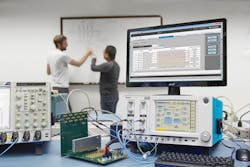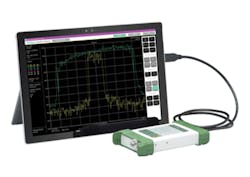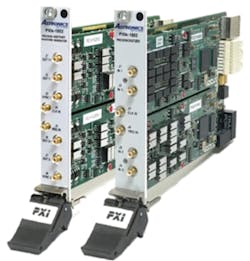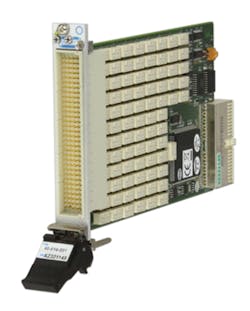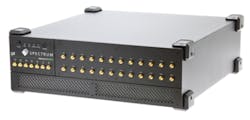Instruments are proliferating in a variety of formats—including benchtop and modular—and spanning the time and frequency domains, as versions released thus far this year demonstrate. Tektronix and Rohde & Schwarz, for example, have respectively introduced a BERT and an oscilloscope while Anritsu has introduced an ultraportable USB millimeter-wave (mmWave) spectrum analyzer. Furthermore, National Instruments has upgraded its multiple-instrument VirtualBench with the addition of a model containing a 500-MHz oscilloscope.
PXI, too, has been a focus of innovation, with Astronics Test Systems and SP Devices introducing PXI instruments, Pickering Interfaces debuting a PXI multiplexor, and Innovative Integration launching a PXIe module with a Xilinx Zynq Z7045 system-on-chip processor. And on the LXI front, Spectrum Instrumentation has added a range of high-speed 14- and 16-bit digitizer products.
Protocol-aware BERT
Although Tektronix this year has debuted an instrument in the traditional benchtop format, what’s inside is far from traditional. Jim Dunford, product manager for the company’s BERTScope product line, called the new Tektronix BSX Series BERTScope (Figure 1) the industry’s first 32-Gb/s protocol-aware bit-error-rate test and analysis system. He said the instrument helps characterize the receiver in Gen3 and Gen4 devices and enables users to shorten the time needed to debug link training and bit-error-rate issues.
Courtesy of Tektronix
Dunford explained some of the trends driving the need for an instrument like the new BERTscope. The 5G rollout is driving bandwidth bottlenecks, cloud service providers are bypassing OEMs to build their own hardware or are turning to ODMs, and a convergence of datacom and enterprise standards is creating new debug challenges as the same designs incorporate 100/400G Ethernet, PCIe, SAS, and DDR5.
Dunford said that data-link receivers are tested by sending them intentionally impaired data to see how much stress they can handle before misinterpreting incoming data. He added that as 4th-generation serial protocols such as PCIe 4.0 and SAS4 become more complex, it has become increasingly difficult to place a receiver being tested into an appropriate state (such as a loopback state) for testing without protocol handshaking between the instrument and the device under test.
That’s where the protocol-aware functions of the BSX Series come into play. The BSX provides the tools and flexibility needed to visualize and control the handshaking and link-training process, understand the protocol, and be able to modify test conditions based on DUT requirements. Dunford said it meets the Rx test challenges of putting the device into loopback mode, performing link equalization, providing autocalibration of stresses, making accurate and repeatable measurements for a large number of test cases, and finding root causes of bit-error or link-training problems. In addition, the BSX Series receiver test tool continuously stores the context (timing, bit position) of each bit error. Error-analysis tools such as pattern-sensitivity and forward-error-correction emulation use this information to help developers understand the factors contributing to bit errors.
With maximum data rates of 12.5 Gb/s, 24 Gb/s, and 32 Gb/s, the BSX Series is available with tools that automate compliance testing, making accurate and repeatable measurements easy to do for the large number of test cases required in the Gen4 standards. With built-in Tx equalization, reference clock multiplication, and interference generation, the BSX Series requires fewer cables and is easier to set up and calibrate than previous offerings.
Lab oscilloscope
Also addressing the benchtop form factor, Rohde & Schwarz has added a new 6-GHz model (Figure 2) to its R&S RTO2000 Series oscilloscopes, opening up measurements on fast communications interfaces and for IoT applications. The characteristics of the compact R&S RTO2000 lab oscilloscopes make them suitable for demanding tasks such as power-integrity measurements. For such applications, the company also offers the R&S RT-ZPR20 low-noise power-rail probe (see “Ensuring high-quality power for today’s product designs”).
Courtesy of Rohde & Schwarz
The new R&S RTO2000’s 6-GHz bandwidth allows developers to test the radio interfaces of 802.11ac WLAN components for IoT modules in the 5-GHz band as well as fast communications interfaces such as USB 3.1 Gen 1 with data rates of 5 Gb/s. Thanks to its multidomain functionality, a single compact instrument can analyze power supplies, processors, and sensors. Synchronized time, frequency, protocol, and logic-analyses results allow users to debug at the system level.
The company said that up to 16-bit vertical resolution in high-definition mode enables developers to detect even the smallest of signal details. Further, the company said, the R&S RTO2000 offers one million waveforms per second, allowing fast identification of even the most sporadic signal faults. The integrated spectrum-analysis and spectrogram display make it possible to observe the signal path in the frequency domain as well as over time.
In addition, a zone trigger lets users isolate events graphically in the time and frequency domain, for example, to separate read and write messages from memory interfaces. The R&S RTO2000 offers a 2-GS memory, so users can analyze even long pulse and protocol sequences. They also can use the history function to retrieve previously acquired waveforms. The high-resolution, 12.1-inch touchscreen and the color-coded controls make the R&S RTO2000 intuitive to use. The app cockpit provides direct access to all available applications, such as trigger and decoding functions, conformance and signal integrity-tests, I/Q analysis, and even customer-specific development tools.
Ultraportable mmWave analyzer
Addressing portability, Anritsu introduced the Spectrum Master MS2760A family, which Russel Lindsay, product marketing manager, Service Infrastructure Solutions Division, described as the first ultraportable, mmWave spectrum analyzers that verify high-frequency designs beyond 50 GHz (Figure 3). Applications, he said, include 5G, E-band building-to-building communications, and V-band satellite-to-satellite and satellite-to aircraft-communications. Still other applications, he said, include electronic warfare and electronic countermeasures. He explained that the instruments leverage Anritsu’s patented NLTL Shockline technology to reduce cost and size while boosting performance.
Courtesy of Anritsu
For R&D and test engineers in lab environments, the MS2760A can measure channel power, adjacent channel power, spurious emissions, and occupied bandwidth. The MS2760A allows measurements to be taken directly at the DUT, unlike benchtop models that require expensive cables that can add loss. Lindsay said the instrument is not a replace-all for every other spectrum analyzer but is an affordable alternative for which you don’t pay for features you don’t use. In addition, he said, it can serve as a supplemental instrument that can keep measurements going while a full-featured analyzer is in use elsewhere in the lab.
The Spectrum Master MS2760A compact size is particularly suitable for field testing. The ultraportable instrument fits in a technician’s pocket, can be powered by a tablet’s USB port, and offers in a single instrument continuous-sweep capability, thereby reducing the amount of equipment the technician must carry. But it also can lower the cost-of-test in high-volume manufacturing applications, as it is less expensive than benchtop alternatives. Its ultraportable size also adds flexibility to production test of larger products, including those in aerospace and satellite applications, Lindsay said.
The Spectrum Master MS2760A has models to support the 32-GHz, 44-GHz, 50-GHz, 70-GHz, and 110-GHz frequencies. A 90-GHz model also is available for countries where an export license is required for analyzers above 90 GHz. It complements Anritsu’s ultraportable analyzer portfolio, which also includes the Power Master MA24507A mmWave power analyzer and Site Master S331P field cable and antenna analyzer.
Multifunction instrument
NI announced in February the VB-8054 instrument (Figure 4), a new higher performance model of VirtualBench. VirtualBench, first introduced in June 2014, plays a key role in reducing the cost and footprint of test and measurement systems by consolidating five of the most commonly used instruments into one device without compromising the performance of each
instrument.
Courtesy of National Instruments
Combined with a modern software experience and simple programming interface, VirtualBench creates new efficiencies for engineers interacting with benchtop test equipment or developing low-cost automated test systems.
“VirtualBench has both an interactive software application as well as APIs for LabVIEW, C, and Python,” said Michael Keane, NI Product marketing engineer for test systems. “This allows the product to uniquely serve engineers who need both light automation and effective, interactive debugging—we have seen this need in both V&V and low-cost production settings. While this need may have been previously served by both automation equipment and traditional benchtop instruments, VirtualBench stands as a single solution for both needs.”
“Engineering workbenches and test systems are getting more and more crowded every day as technologies converge in the latest smart devices,” added Luke Schreier, director of automated test product marketing at NI. “VirtualBench provides the ideal combination of capability at performance levels that can legitimately replace five or more instruments needed to characterize new product designs or validate assembled units on a production floor. With 500 MHz of scope bandwidth and a faster generator in the latest model, VirtualBench meets the needs of even more engineers wrestling with how to lower their cost of capital equipment.”
Here are the key new features of the VB-8054:
- a four-channel, 500-MHz mixed-signal oscilloscope with 2-GS/s sampling rate and protocol analysis (34 digital channels); and
- a function generator with 40-MHz max sine output plus 5-MHz output for square, ramp/triangle, DC, and arbitrary modes.
Here are some additional capabilities of the VirtualBench family:
- true 5½-digit DMM with 300-V input range, three-channel programmable DC power supply (up to 3 A), and eight general-purpose digital I/O lines;
- intuitive, unified software view of all five instruments, visualization on larger displays, and quick functionality to save data and screenshots;
- USB, Ethernet, and Wi-Fi connectivity to Windows software application and Wi-Fi connectivity to Apple iPad software application; and
- programming interfaces to automate measurements in LabVIEW and C environments.
The VirtualBench application requires zero installation and can load automatically through Windows AutoPlay when connected through USB. VirtualBench also includes software capabilities like digital phosphor density maps for displaying multiple acquisitions simultaneously, X-Y mode for plotting channels against one another, and hands-free smart capture for automatic data capture of repeated stable waveforms. To help better maintain the value of any VirtualBench investment, NI provides free software and firmware updates as new features are released. These features, in addition to the consolidated interface, help engineers streamline their approach for benchtop characterization and validation. The small footprint and low price of VirtualBench compared with its equivalent set of boxes help enable lower cost of test on a manufacturing floor.
The VirtualBench hardware family consists of three models most easily designated by oscilloscope analog bandwidth: 100, 350, and 500 MHz. Through these models, the VirtualBench family serves a range of applications and price points in academic labs, hardware characterization/debug benches, and automated test systems.
“From the beginning,” said Keane, “the VirtualBench product line was intended to be a family of options, and the new 500-MHz model completes this entry-level family that also includes 100- and 350-MHz models that serve a variety of application needs.”
PXI instruments
Astronics Test Systems has begun 2017 by introducing two new test instruments: the new PXIe-1802 arbitrary waveform generator and the new PXIe-1803 digitizer (Figure 5), which serve aerospace, defense, communications, and other high-reliability applications.
Courtesy of Astronics Test Systems
“The demand for high-performance PXI test instruments continues to rise both as legacy test systems are upgraded with additional functionality and as new systems are introduced,” explained Steve Fairbanks, senior director of product marketing for Astronics Test Systems, in a press release. “Our latest additions to our product portfolio enhance our capability to provide a breadth of test functionality for next generation test
initiatives.”
The PXIe-1802 arbitrary waveform generator (AWG) offers both speed and performance for output frequencies of up to 125 MHz. With built-in waveforms, high signal quality, high density and modularity, and other features, this AWG delivers dual 14-/16-bit waveform generator channels, bandwidths of 90 to 140 MHz, synchronization, and 250-μV measurement accuracy.
The PXIe-1803 is a 130/180-MS/s dual-channel digitizer that supports input frequencies up to 175 MHz, the company said. The new dual-channel 14-/16-bit digitizer is configurable with separate or fully synchronized channels. Other features include waveform bandwidths of 65 to 175 MHz (typical), 64M of waveform memory per channel, and relative accuracy of up to 0.006%.
Pickering Interfaces also has begun 2017 with new PXI products—the 40-614 family of high-density 2-A PXI multiplexers (Figure 6), available in 20 different configurations and designed for signal routing in ATE and data-acquisition systems. The multiplexers use high-quality electromechanical signal relays, allowing each channel to switch voltages up to 200 VDC/140 VAC at the 2-A current rating.
Courtesy of Pickering Interfaces
“These multiplexers offer a low-cost fixed-configuration alternative to versatile solutions, making them simpler to program, and it also improves isolation between banks,” commented Shaun Fuller, Pickering’s switching product manager, in a press release.
The PXI multiplexers may be operated as conventional multiplexers with break-before-make action when a new channel is selected. In addition, multiple channels may be simultaneously selected on the two-, four-, eight-, 16-, and 32-pole versions. Large multiplexers may be constructed by daisy-chaining the common signals from multiple PXI modules.
The product range also is supported by several Pickering software and hardware tools, including the eBIRST switching system test tools, which provide a quick and simple way of finding relay failures within modules; and Switch Path Manager, which simplifies signal routing through complex switching systems.
From-factor, connectivity options
Addressing a variety of form-factor and connectivity options, SP Devices, an e2v company, has launched the ADQ7, which it calls the first digitizer to combine 14-bit vertical resolution with a sampling rate of up to 10 GS/s.
Following on the company’s ADQ14 digitizer, the ADQ7 provides a higher sampling rate, larger FPGA, increased memory and data transfer rate, and a higher bandwidth analog front end. The ADQ7’s combination of high bandwidth and high dynamic range makes it suitable for applications such as those involving LiDAR, radar, mass spectrometry, radio-frequency sampling and recording, and automated test.
The ADQ7 hosts a Xilinx Ultrascale XCKU060 FPGA, which can be accessed through a firmware development kit. In addition, to help shorten design time, a number of optional standalone firmware packages contain application-specific, real-time signal-processing functions. These flexible firmware solutions make the ADQ7 suitable for OEM integration.
Jan-Erik Eklund, digitizer product manager at SP Devices, commented in a press release, “It is very exciting that we can offer the market a 14-bit resolution digitizer that maintains such a high sampling rate. This new digitizer’s unique performance shows our commitment to innovation and maintaining our position as the world leader in high-performance data acquisition.”
The ADQ7 will be available in form factors and connectivity options including MicroTCA (MTCA.4), USB 3.0, PCIe, PXIe, and 10 GbE, and it supports sustained data-transfer rates of up to 5 GB/s (with PCIe). A software development kit is included free and supports multiple languages including C++, C#, Matlab, Python, and LabVIEW. The board can be operated under both Windows and Linux.
LXI digitizers
Also addressing the high-resolution digitizer market is Spectrum Instrumentation, which has added a range of high-speed 14- and 16-bit digitizer products, designated DN6.44X, to its digitizerNETBOX family (Figure 7) for applications where multiple electronic signals need to be acquired and analyzed. The company said its new instruments feature up to 24 fully synchronized channels. The 16-bit ADC models offer sampling rates of either 130 MS/s or 250 MS/s, while the 14-bit units feature sampling rates of 500 MS/s.
Courtesy of Spectrum Instrumentation
The high sampling rates and resolutions make the DN6.44x Series suitable for wide-band signal capture. The high channel density supports applications where arrays of receivers, sensors, detectors, rectifiers, antennas, and other electronic devices are to be used and tested.
To ensure all models deliver suitable cross-channel timing capability with minimal phase error, the ADCs on each channel are clocked synchronously. Each channel also is equipped with its own front-end amplifier that features six input ranges (from ±200 mV up to ±10 V full scale), switchable input impedance (50 Ω and 1 MΩ), and programmable positive input offset for unipolar signals. The analog bandwidth is as high as 250 MHz (for 500-MS/s models).
Each DN6.44x instrument is equipped with a large onboard acquisition memory of 512 MS/channel and trigger circuitry to allow the capture of a range of input signals. Each channel as well as two external inputs can act as a trigger source with the capability of combining all sources by AND/OR logic function. Different acquisition modes, which include single-shot (transient recording), streaming (FIFO), segmented (multiple recording), gated (gated sampling), or a combination of segmented and slow chart-recorder operation (ABA mode), can be combined with internal-trigger time stamping.
The units feature an industrial chassis with integrated cooling, a replaceable dust filter, and low-noise power supplies. Front-panel SMA connectors are used for the channel inputs, external clock, and external triggering, while LED lights provide a visual indication for the power, trigger, and LAN status. Based on the LXI instrumentation standard (following the LXI Device Specification 2011 rev. 1.4), the digitizerNETBOX products also are designed for automated testing and remote applications. Full remote control is achieved through a simple gigabit Ethernet port, which allows connection to any PC or LAN.
CPUs plus FPGA fabric
Finally, an instrument system might need some processing power. To that end, Innovative Integration, a Molex company, has announced the COPious-PXIe. The 8HP PXIe-compatible plug-in card employs the Xilinx Zynq Z7045 system-on-chip processor, which provides dual floating-point ARM A9 CPUs and a large user-programmable FPGA fabric.
COPious-PXIe incorporates a high-pin-count VITA 57.1-compliant FMC module site, compatible with Innovative’s range of FMC modules and tools. The onboard FPGA fabric directly controls FMC peripherals, enabling deep integration of sophisticated, user-customized DSP algorithms. The module serves software-defined-radio, radar, LiDAR, optical-control, and other demanding applications, which it can efficiently address even in conjunction with conventional PXIe system controllers running non-real-time operating systems such as Windows or Linux.
“This powerful single-board computer/adapter adds a rich portfolio of cutting-edge DAQ FMC modules and tools into the PXIe ecosystem,” said Jim Henderson, president of Innovative Integration, in a press release. Customers can implement custom control, communications, and analytical algorithms within the Zynq’s copious on-chip FPGA fabric to perform real-time signal processing of signals with up to 500 MHz of instantaneous bandwidth.”
The product can be tailored to a variety of markets including embedded and mobile instrumentation, remote and autonomous I/O, and distributed data acquisition.
For more information

